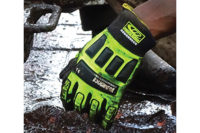A NIOSH Science Blog post
Exoskeletons in Construction: Will they reduce or create hazards?

Credit: Getty Images
By Alissa Zingman, MD; G. Scott Earnest, PhD, PE, CSP; Brian D. Lowe, PhD, CPE; Christine M. Branche, Ph.D., FACE
Wearable exoskeleton devices can reduce some of the mechanical stress of manual labor (1). These wearable machines can be powered by electricity or by human motion, and they can be as large as a space suit or as small as a glove. (1; 2) They are used to amplify or transform worker movements, improve biomechanics and efficiency, and are increasingly prevalent in the public and private sectors. NIOSH published its first blog on this topic in 2016 (3). As these devices are deployed more widely in the workplace, sound research is required to assess potential dangers and benefits of this new technology.
Construction is a physically demanding, labor-intensive industry with heavy manual material handling and awkward work postures. Musculoskeletal disorders (MSDs) are a leading cause of injury among construction workers (4; 5), with overexertion in lifting causing over one-third of these injuries. (6) The rate of work-related musculoskeletal disorders in construction is 16% higher than in all industries combined(5). Since back injuries are the most prevalent work-related musculoskeletal disorders in construction, (5) and shoulder and other joint injuries are also major causes of injury, exoskeletons present an attractive possibility.
In a study of forward bend lifting using an exoskeleton designed to decrease load to the spine and improve posture, researchers found that exoskeletons decrease total work, fatigue and load while improving posture. (1) This is supported by additional studies (1; 7). In addition to decreasing load on the spine, exoskeletons have been shown to decrease shoulder discomfort while increasing productivity and work quality among painters and welders (8).
While these benefits are promising, exoskeletons also introduce new risk factors. The same study also demonstrated increased chest pressure due to wearing the device.(1) This could negatively impact workers, particularly those with pre-existing conditions, such as chronic obstructive pulmonary disease (COPD). There are other potential risks to exoskeleton use. The weight of devices designed for extending reach could result in inadvertent increased load to the spine. Poor fit could cause pressure wounds or compressed nerves. Lack of hygienic practices for devices used by multiple users could spread infectious diseases.
Some exoskeletons are unwieldy or cumbersome and may limit users mobility including the ability to move out of the way of a falling object. They also could shift the user’s center of gravity causing such problems and diminished recovery strategy, the human body’s response to loss of balance. Data shows that human recovery strategy following a collision was…Click here to read the rest of the blog post.
Looking for a reprint of this article?
From high-res PDFs to custom plaques, order your copy today!






